Case Study on Nursing Care for a Stroke Patient
VerifiedAdded on 2022/11/14
|12
|2844
|454
AI Summary
This document is a case study on nursing care for a stroke patient. It discusses the role of an enrolled nurse, the causes of stroke, and the interventions of a dietician, physiotherapist, and general practitioner. It also explains the causes of osteoporosis and impaired physical mobility. Lastly, it talks about the side effects of painkillers and the interventions for incontinence-associated dermatitis.
Contribute Materials
Your contribution can guide someone’s learning journey. Share your
documents today.
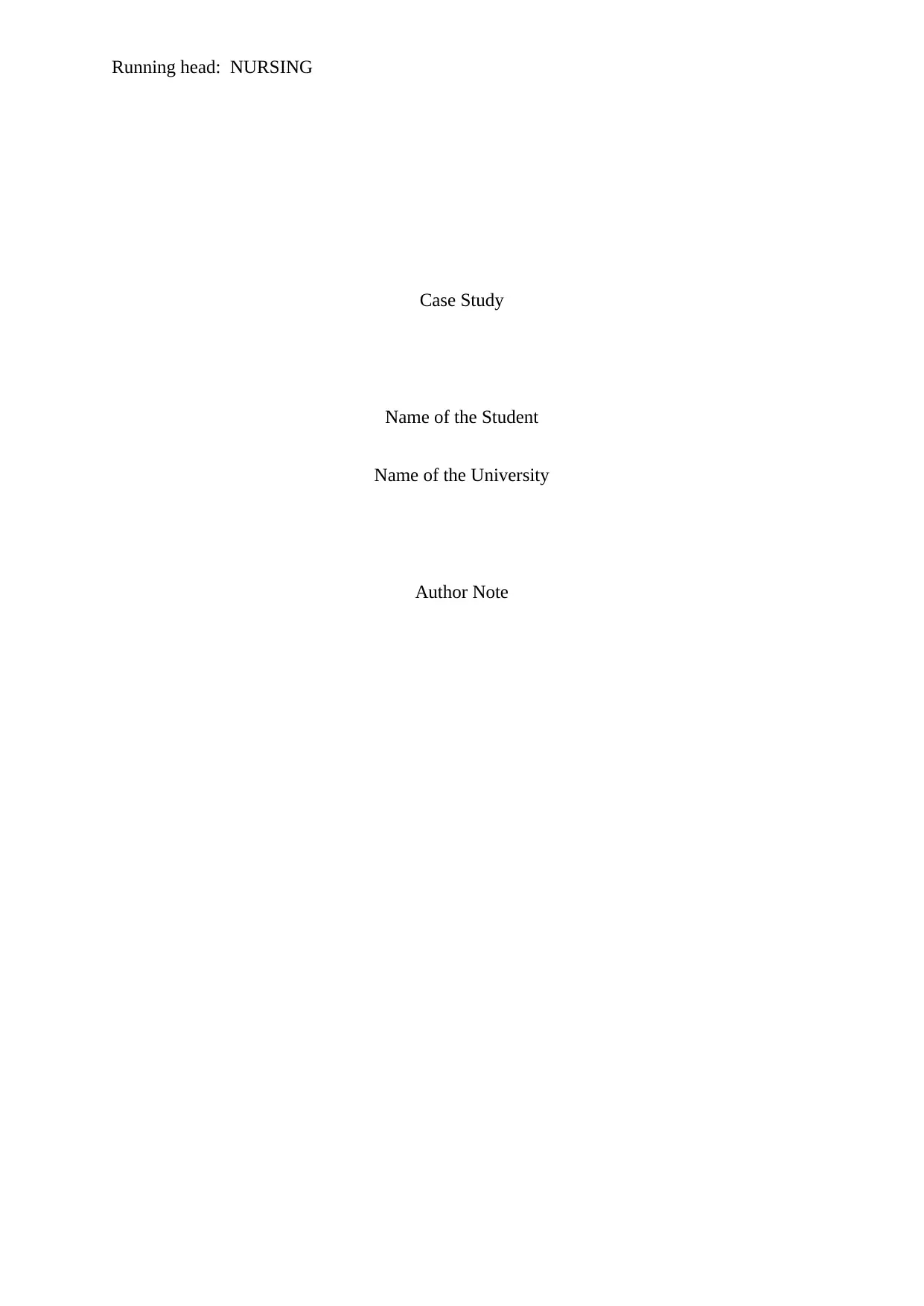
Running head: NURSING
Case Study
Name of the Student
Name of the University
Author Note
Case Study
Name of the Student
Name of the University
Author Note
Secure Best Marks with AI Grader
Need help grading? Try our AI Grader for instant feedback on your assignments.
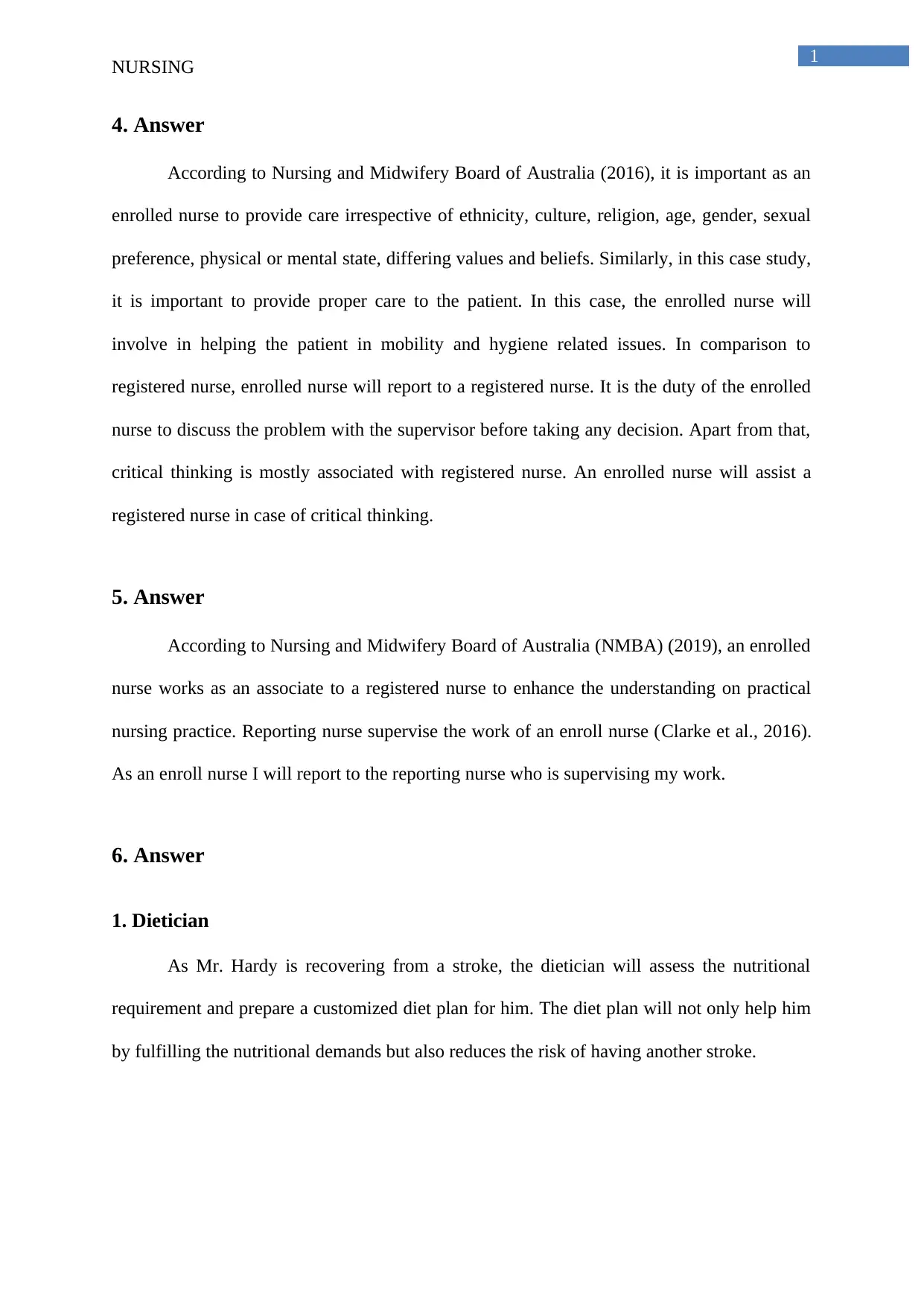
1
NURSING
4. Answer
According to Nursing and Midwifery Board of Australia (2016), it is important as an
enrolled nurse to provide care irrespective of ethnicity, culture, religion, age, gender, sexual
preference, physical or mental state, differing values and beliefs. Similarly, in this case study,
it is important to provide proper care to the patient. In this case, the enrolled nurse will
involve in helping the patient in mobility and hygiene related issues. In comparison to
registered nurse, enrolled nurse will report to a registered nurse. It is the duty of the enrolled
nurse to discuss the problem with the supervisor before taking any decision. Apart from that,
critical thinking is mostly associated with registered nurse. An enrolled nurse will assist a
registered nurse in case of critical thinking.
5. Answer
According to Nursing and Midwifery Board of Australia (NMBA) (2019), an enrolled
nurse works as an associate to a registered nurse to enhance the understanding on practical
nursing practice. Reporting nurse supervise the work of an enroll nurse (Clarke et al., 2016).
As an enroll nurse I will report to the reporting nurse who is supervising my work.
6. Answer
1. Dietician
As Mr. Hardy is recovering from a stroke, the dietician will assess the nutritional
requirement and prepare a customized diet plan for him. The diet plan will not only help him
by fulfilling the nutritional demands but also reduces the risk of having another stroke.
NURSING
4. Answer
According to Nursing and Midwifery Board of Australia (2016), it is important as an
enrolled nurse to provide care irrespective of ethnicity, culture, religion, age, gender, sexual
preference, physical or mental state, differing values and beliefs. Similarly, in this case study,
it is important to provide proper care to the patient. In this case, the enrolled nurse will
involve in helping the patient in mobility and hygiene related issues. In comparison to
registered nurse, enrolled nurse will report to a registered nurse. It is the duty of the enrolled
nurse to discuss the problem with the supervisor before taking any decision. Apart from that,
critical thinking is mostly associated with registered nurse. An enrolled nurse will assist a
registered nurse in case of critical thinking.
5. Answer
According to Nursing and Midwifery Board of Australia (NMBA) (2019), an enrolled
nurse works as an associate to a registered nurse to enhance the understanding on practical
nursing practice. Reporting nurse supervise the work of an enroll nurse (Clarke et al., 2016).
As an enroll nurse I will report to the reporting nurse who is supervising my work.
6. Answer
1. Dietician
As Mr. Hardy is recovering from a stroke, the dietician will assess the nutritional
requirement and prepare a customized diet plan for him. The diet plan will not only help him
by fulfilling the nutritional demands but also reduces the risk of having another stroke.
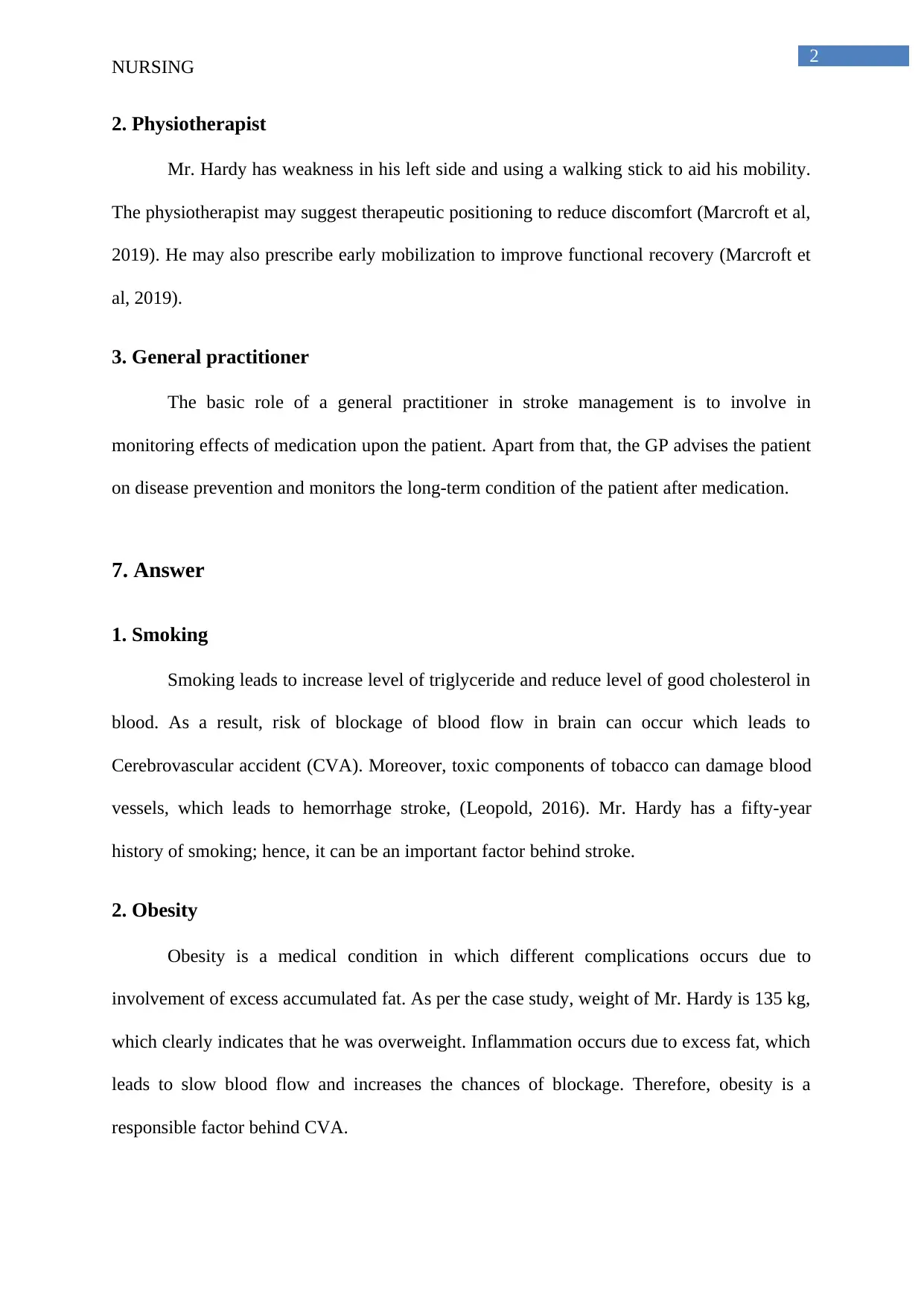
2
NURSING
2. Physiotherapist
Mr. Hardy has weakness in his left side and using a walking stick to aid his mobility.
The physiotherapist may suggest therapeutic positioning to reduce discomfort (Marcroft et al,
2019). He may also prescribe early mobilization to improve functional recovery (Marcroft et
al, 2019).
3. General practitioner
The basic role of a general practitioner in stroke management is to involve in
monitoring effects of medication upon the patient. Apart from that, the GP advises the patient
on disease prevention and monitors the long-term condition of the patient after medication.
7. Answer
1. Smoking
Smoking leads to increase level of triglyceride and reduce level of good cholesterol in
blood. As a result, risk of blockage of blood flow in brain can occur which leads to
Cerebrovascular accident (CVA). Moreover, toxic components of tobacco can damage blood
vessels, which leads to hemorrhage stroke, (Leopold, 2016). Mr. Hardy has a fifty-year
history of smoking; hence, it can be an important factor behind stroke.
2. Obesity
Obesity is a medical condition in which different complications occurs due to
involvement of excess accumulated fat. As per the case study, weight of Mr. Hardy is 135 kg,
which clearly indicates that he was overweight. Inflammation occurs due to excess fat, which
leads to slow blood flow and increases the chances of blockage. Therefore, obesity is a
responsible factor behind CVA.
NURSING
2. Physiotherapist
Mr. Hardy has weakness in his left side and using a walking stick to aid his mobility.
The physiotherapist may suggest therapeutic positioning to reduce discomfort (Marcroft et al,
2019). He may also prescribe early mobilization to improve functional recovery (Marcroft et
al, 2019).
3. General practitioner
The basic role of a general practitioner in stroke management is to involve in
monitoring effects of medication upon the patient. Apart from that, the GP advises the patient
on disease prevention and monitors the long-term condition of the patient after medication.
7. Answer
1. Smoking
Smoking leads to increase level of triglyceride and reduce level of good cholesterol in
blood. As a result, risk of blockage of blood flow in brain can occur which leads to
Cerebrovascular accident (CVA). Moreover, toxic components of tobacco can damage blood
vessels, which leads to hemorrhage stroke, (Leopold, 2016). Mr. Hardy has a fifty-year
history of smoking; hence, it can be an important factor behind stroke.
2. Obesity
Obesity is a medical condition in which different complications occurs due to
involvement of excess accumulated fat. As per the case study, weight of Mr. Hardy is 135 kg,
which clearly indicates that he was overweight. Inflammation occurs due to excess fat, which
leads to slow blood flow and increases the chances of blockage. Therefore, obesity is a
responsible factor behind CVA.
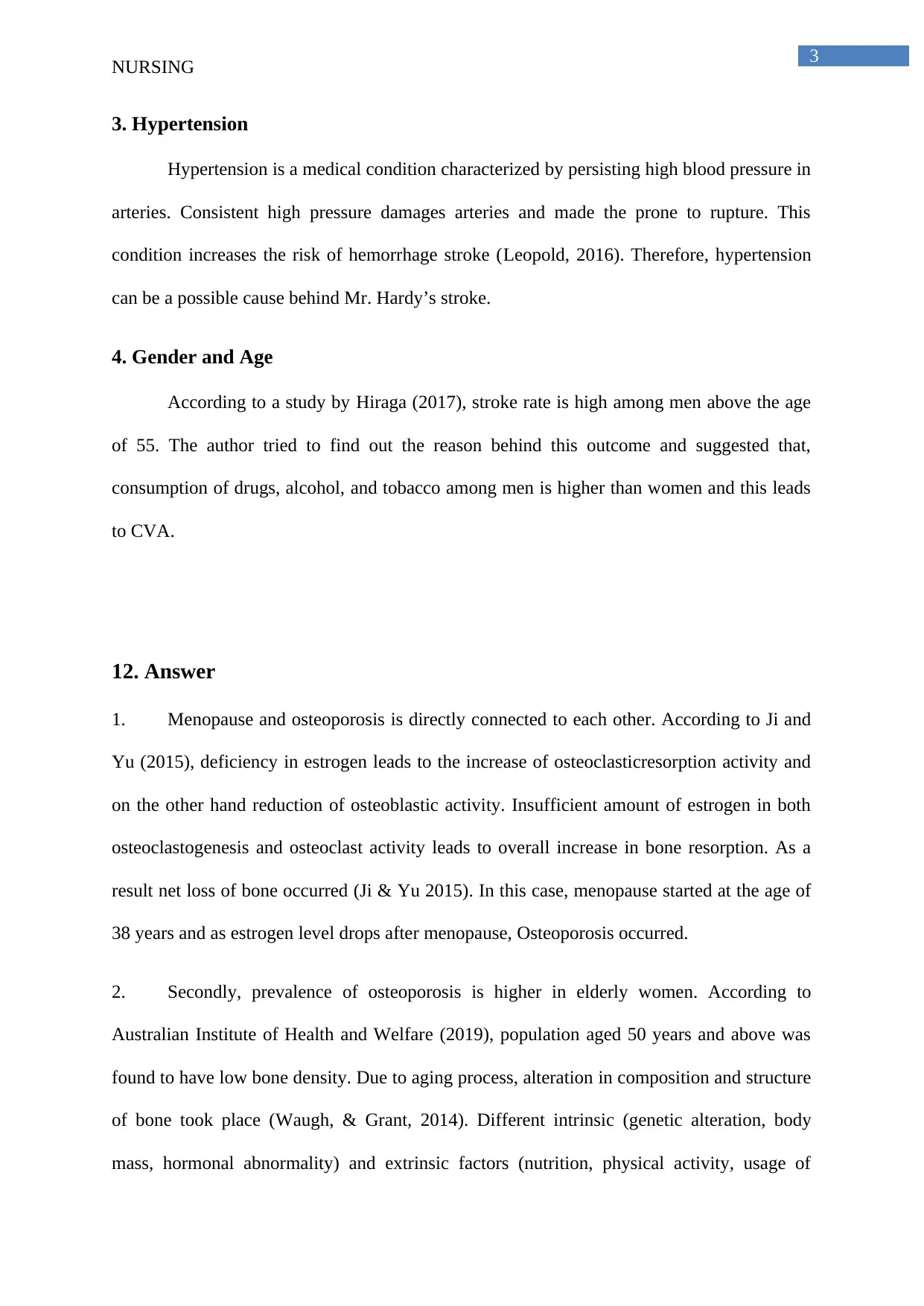
3
NURSING
3. Hypertension
Hypertension is a medical condition characterized by persisting high blood pressure in
arteries. Consistent high pressure damages arteries and made the prone to rupture. This
condition increases the risk of hemorrhage stroke (Leopold, 2016). Therefore, hypertension
can be a possible cause behind Mr. Hardy’s stroke.
4. Gender and Age
According to a study by Hiraga (2017), stroke rate is high among men above the age
of 55. The author tried to find out the reason behind this outcome and suggested that,
consumption of drugs, alcohol, and tobacco among men is higher than women and this leads
to CVA.
12. Answer
1. Menopause and osteoporosis is directly connected to each other. According to Ji and
Yu (2015), deficiency in estrogen leads to the increase of osteoclasticresorption activity and
on the other hand reduction of osteoblastic activity. Insufficient amount of estrogen in both
osteoclastogenesis and osteoclast activity leads to overall increase in bone resorption. As a
result net loss of bone occurred (Ji & Yu 2015). In this case, menopause started at the age of
38 years and as estrogen level drops after menopause, Osteoporosis occurred.
2. Secondly, prevalence of osteoporosis is higher in elderly women. According to
Australian Institute of Health and Welfare (2019), population aged 50 years and above was
found to have low bone density. Due to aging process, alteration in composition and structure
of bone took place (Waugh, & Grant, 2014). Different intrinsic (genetic alteration, body
mass, hormonal abnormality) and extrinsic factors (nutrition, physical activity, usage of
NURSING
3. Hypertension
Hypertension is a medical condition characterized by persisting high blood pressure in
arteries. Consistent high pressure damages arteries and made the prone to rupture. This
condition increases the risk of hemorrhage stroke (Leopold, 2016). Therefore, hypertension
can be a possible cause behind Mr. Hardy’s stroke.
4. Gender and Age
According to a study by Hiraga (2017), stroke rate is high among men above the age
of 55. The author tried to find out the reason behind this outcome and suggested that,
consumption of drugs, alcohol, and tobacco among men is higher than women and this leads
to CVA.
12. Answer
1. Menopause and osteoporosis is directly connected to each other. According to Ji and
Yu (2015), deficiency in estrogen leads to the increase of osteoclasticresorption activity and
on the other hand reduction of osteoblastic activity. Insufficient amount of estrogen in both
osteoclastogenesis and osteoclast activity leads to overall increase in bone resorption. As a
result net loss of bone occurred (Ji & Yu 2015). In this case, menopause started at the age of
38 years and as estrogen level drops after menopause, Osteoporosis occurred.
2. Secondly, prevalence of osteoporosis is higher in elderly women. According to
Australian Institute of Health and Welfare (2019), population aged 50 years and above was
found to have low bone density. Due to aging process, alteration in composition and structure
of bone took place (Waugh, & Grant, 2014). Different intrinsic (genetic alteration, body
mass, hormonal abnormality) and extrinsic factors (nutrition, physical activity, usage of
Secure Best Marks with AI Grader
Need help grading? Try our AI Grader for instant feedback on your assignments.
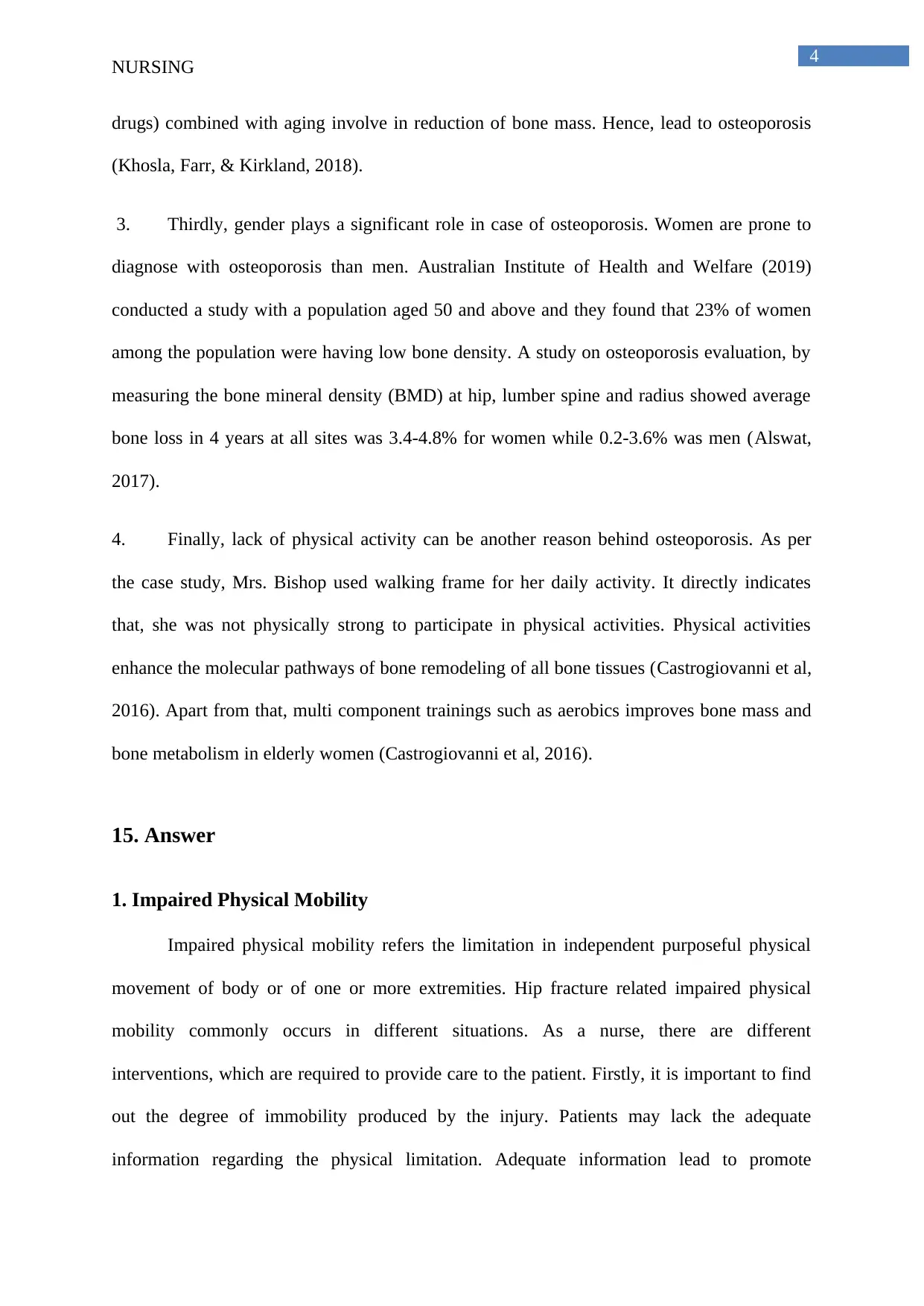
4
NURSING
drugs) combined with aging involve in reduction of bone mass. Hence, lead to osteoporosis
(Khosla, Farr, & Kirkland, 2018).
3. Thirdly, gender plays a significant role in case of osteoporosis. Women are prone to
diagnose with osteoporosis than men. Australian Institute of Health and Welfare (2019)
conducted a study with a population aged 50 and above and they found that 23% of women
among the population were having low bone density. A study on osteoporosis evaluation, by
measuring the bone mineral density (BMD) at hip, lumber spine and radius showed average
bone loss in 4 years at all sites was 3.4-4.8% for women while 0.2-3.6% was men (Alswat,
2017).
4. Finally, lack of physical activity can be another reason behind osteoporosis. As per
the case study, Mrs. Bishop used walking frame for her daily activity. It directly indicates
that, she was not physically strong to participate in physical activities. Physical activities
enhance the molecular pathways of bone remodeling of all bone tissues (Castrogiovanni et al,
2016). Apart from that, multi component trainings such as aerobics improves bone mass and
bone metabolism in elderly women (Castrogiovanni et al, 2016).
15. Answer
1. Impaired Physical Mobility
Impaired physical mobility refers the limitation in independent purposeful physical
movement of body or of one or more extremities. Hip fracture related impaired physical
mobility commonly occurs in different situations. As a nurse, there are different
interventions, which are required to provide care to the patient. Firstly, it is important to find
out the degree of immobility produced by the injury. Patients may lack the adequate
information regarding the physical limitation. Adequate information lead to promote
NURSING
drugs) combined with aging involve in reduction of bone mass. Hence, lead to osteoporosis
(Khosla, Farr, & Kirkland, 2018).
3. Thirdly, gender plays a significant role in case of osteoporosis. Women are prone to
diagnose with osteoporosis than men. Australian Institute of Health and Welfare (2019)
conducted a study with a population aged 50 and above and they found that 23% of women
among the population were having low bone density. A study on osteoporosis evaluation, by
measuring the bone mineral density (BMD) at hip, lumber spine and radius showed average
bone loss in 4 years at all sites was 3.4-4.8% for women while 0.2-3.6% was men (Alswat,
2017).
4. Finally, lack of physical activity can be another reason behind osteoporosis. As per
the case study, Mrs. Bishop used walking frame for her daily activity. It directly indicates
that, she was not physically strong to participate in physical activities. Physical activities
enhance the molecular pathways of bone remodeling of all bone tissues (Castrogiovanni et al,
2016). Apart from that, multi component trainings such as aerobics improves bone mass and
bone metabolism in elderly women (Castrogiovanni et al, 2016).
15. Answer
1. Impaired Physical Mobility
Impaired physical mobility refers the limitation in independent purposeful physical
movement of body or of one or more extremities. Hip fracture related impaired physical
mobility commonly occurs in different situations. As a nurse, there are different
interventions, which are required to provide care to the patient. Firstly, it is important to find
out the degree of immobility produced by the injury. Patients may lack the adequate
information regarding the physical limitation. Adequate information lead to promote
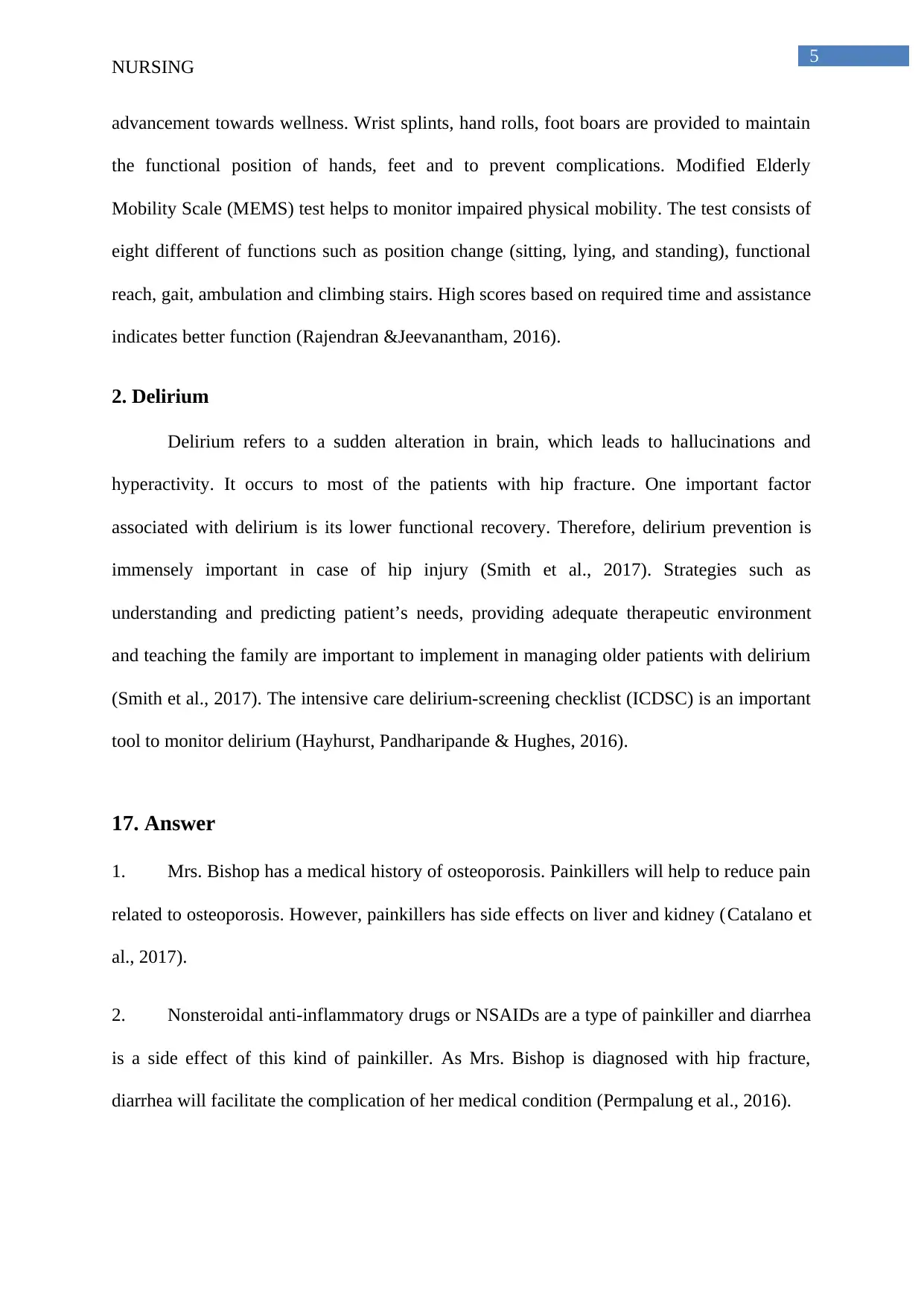
5
NURSING
advancement towards wellness. Wrist splints, hand rolls, foot boars are provided to maintain
the functional position of hands, feet and to prevent complications. Modified Elderly
Mobility Scale (MEMS) test helps to monitor impaired physical mobility. The test consists of
eight different of functions such as position change (sitting, lying, and standing), functional
reach, gait, ambulation and climbing stairs. High scores based on required time and assistance
indicates better function (Rajendran &Jeevanantham, 2016).
2. Delirium
Delirium refers to a sudden alteration in brain, which leads to hallucinations and
hyperactivity. It occurs to most of the patients with hip fracture. One important factor
associated with delirium is its lower functional recovery. Therefore, delirium prevention is
immensely important in case of hip injury (Smith et al., 2017). Strategies such as
understanding and predicting patient’s needs, providing adequate therapeutic environment
and teaching the family are important to implement in managing older patients with delirium
(Smith et al., 2017). The intensive care delirium-screening checklist (ICDSC) is an important
tool to monitor delirium (Hayhurst, Pandharipande & Hughes, 2016).
17. Answer
1. Mrs. Bishop has a medical history of osteoporosis. Painkillers will help to reduce pain
related to osteoporosis. However, painkillers has side effects on liver and kidney (Catalano et
al., 2017).
2. Nonsteroidal anti-inflammatory drugs or NSAIDs are a type of painkiller and diarrhea
is a side effect of this kind of painkiller. As Mrs. Bishop is diagnosed with hip fracture,
diarrhea will facilitate the complication of her medical condition (Permpalung et al., 2016).
NURSING
advancement towards wellness. Wrist splints, hand rolls, foot boars are provided to maintain
the functional position of hands, feet and to prevent complications. Modified Elderly
Mobility Scale (MEMS) test helps to monitor impaired physical mobility. The test consists of
eight different of functions such as position change (sitting, lying, and standing), functional
reach, gait, ambulation and climbing stairs. High scores based on required time and assistance
indicates better function (Rajendran &Jeevanantham, 2016).
2. Delirium
Delirium refers to a sudden alteration in brain, which leads to hallucinations and
hyperactivity. It occurs to most of the patients with hip fracture. One important factor
associated with delirium is its lower functional recovery. Therefore, delirium prevention is
immensely important in case of hip injury (Smith et al., 2017). Strategies such as
understanding and predicting patient’s needs, providing adequate therapeutic environment
and teaching the family are important to implement in managing older patients with delirium
(Smith et al., 2017). The intensive care delirium-screening checklist (ICDSC) is an important
tool to monitor delirium (Hayhurst, Pandharipande & Hughes, 2016).
17. Answer
1. Mrs. Bishop has a medical history of osteoporosis. Painkillers will help to reduce pain
related to osteoporosis. However, painkillers has side effects on liver and kidney (Catalano et
al., 2017).
2. Nonsteroidal anti-inflammatory drugs or NSAIDs are a type of painkiller and diarrhea
is a side effect of this kind of painkiller. As Mrs. Bishop is diagnosed with hip fracture,
diarrhea will facilitate the complication of her medical condition (Permpalung et al., 2016).
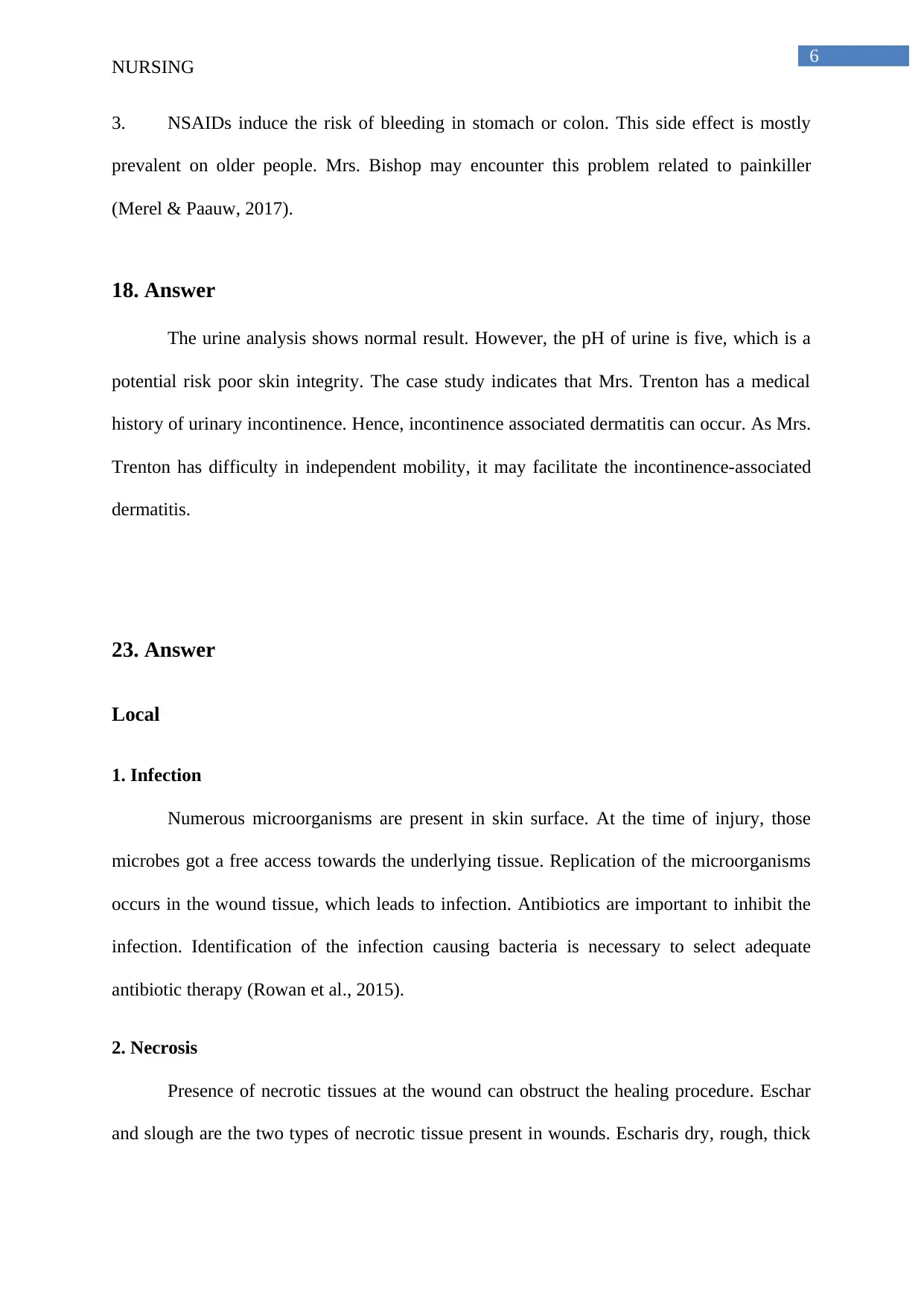
6
NURSING
3. NSAIDs induce the risk of bleeding in stomach or colon. This side effect is mostly
prevalent on older people. Mrs. Bishop may encounter this problem related to painkiller
(Merel & Paauw, 2017).
18. Answer
The urine analysis shows normal result. However, the pH of urine is five, which is a
potential risk poor skin integrity. The case study indicates that Mrs. Trenton has a medical
history of urinary incontinence. Hence, incontinence associated dermatitis can occur. As Mrs.
Trenton has difficulty in independent mobility, it may facilitate the incontinence-associated
dermatitis.
23. Answer
Local
1. Infection
Numerous microorganisms are present in skin surface. At the time of injury, those
microbes got a free access towards the underlying tissue. Replication of the microorganisms
occurs in the wound tissue, which leads to infection. Antibiotics are important to inhibit the
infection. Identification of the infection causing bacteria is necessary to select adequate
antibiotic therapy (Rowan et al., 2015).
2. Necrosis
Presence of necrotic tissues at the wound can obstruct the healing procedure. Eschar
and slough are the two types of necrotic tissue present in wounds. Escharis dry, rough, thick
NURSING
3. NSAIDs induce the risk of bleeding in stomach or colon. This side effect is mostly
prevalent on older people. Mrs. Bishop may encounter this problem related to painkiller
(Merel & Paauw, 2017).
18. Answer
The urine analysis shows normal result. However, the pH of urine is five, which is a
potential risk poor skin integrity. The case study indicates that Mrs. Trenton has a medical
history of urinary incontinence. Hence, incontinence associated dermatitis can occur. As Mrs.
Trenton has difficulty in independent mobility, it may facilitate the incontinence-associated
dermatitis.
23. Answer
Local
1. Infection
Numerous microorganisms are present in skin surface. At the time of injury, those
microbes got a free access towards the underlying tissue. Replication of the microorganisms
occurs in the wound tissue, which leads to infection. Antibiotics are important to inhibit the
infection. Identification of the infection causing bacteria is necessary to select adequate
antibiotic therapy (Rowan et al., 2015).
2. Necrosis
Presence of necrotic tissues at the wound can obstruct the healing procedure. Eschar
and slough are the two types of necrotic tissue present in wounds. Escharis dry, rough, thick
Paraphrase This Document
Need a fresh take? Get an instant paraphrase of this document with our AI Paraphraser
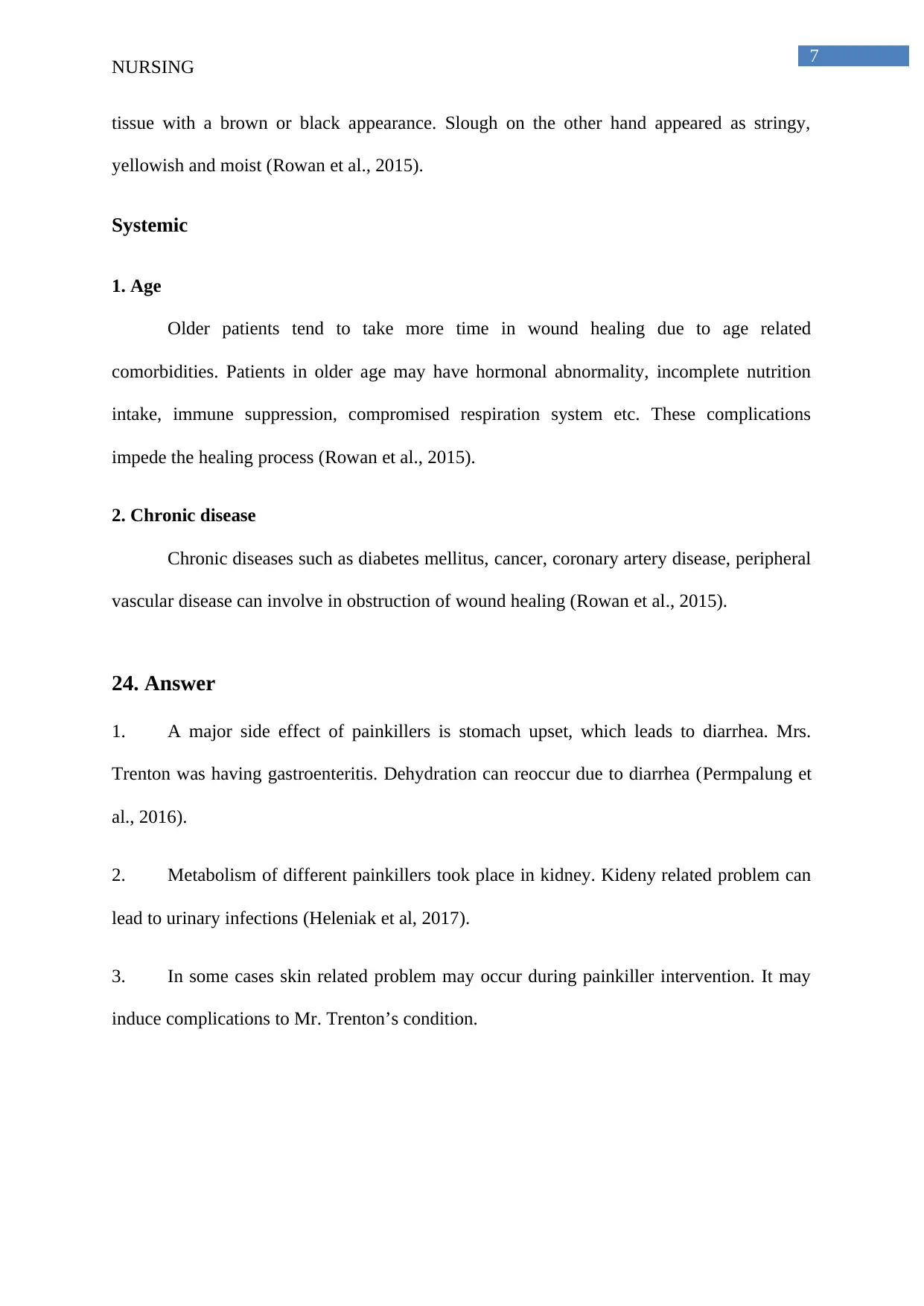
7
NURSING
tissue with a brown or black appearance. Slough on the other hand appeared as stringy,
yellowish and moist (Rowan et al., 2015).
Systemic
1. Age
Older patients tend to take more time in wound healing due to age related
comorbidities. Patients in older age may have hormonal abnormality, incomplete nutrition
intake, immune suppression, compromised respiration system etc. These complications
impede the healing process (Rowan et al., 2015).
2. Chronic disease
Chronic diseases such as diabetes mellitus, cancer, coronary artery disease, peripheral
vascular disease can involve in obstruction of wound healing (Rowan et al., 2015).
24. Answer
1. A major side effect of painkillers is stomach upset, which leads to diarrhea. Mrs.
Trenton was having gastroenteritis. Dehydration can reoccur due to diarrhea (Permpalung et
al., 2016).
2. Metabolism of different painkillers took place in kidney. Kideny related problem can
lead to urinary infections (Heleniak et al, 2017).
3. In some cases skin related problem may occur during painkiller intervention. It may
induce complications to Mr. Trenton’s condition.
NURSING
tissue with a brown or black appearance. Slough on the other hand appeared as stringy,
yellowish and moist (Rowan et al., 2015).
Systemic
1. Age
Older patients tend to take more time in wound healing due to age related
comorbidities. Patients in older age may have hormonal abnormality, incomplete nutrition
intake, immune suppression, compromised respiration system etc. These complications
impede the healing process (Rowan et al., 2015).
2. Chronic disease
Chronic diseases such as diabetes mellitus, cancer, coronary artery disease, peripheral
vascular disease can involve in obstruction of wound healing (Rowan et al., 2015).
24. Answer
1. A major side effect of painkillers is stomach upset, which leads to diarrhea. Mrs.
Trenton was having gastroenteritis. Dehydration can reoccur due to diarrhea (Permpalung et
al., 2016).
2. Metabolism of different painkillers took place in kidney. Kideny related problem can
lead to urinary infections (Heleniak et al, 2017).
3. In some cases skin related problem may occur during painkiller intervention. It may
induce complications to Mr. Trenton’s condition.

8
NURSING
25. Answer
Mrs. Trenton requires assistance for mobility and she has a medical history of urinary
incontinence. In this situation, incontinence associated dermatitis can occur due to acidic
urine (Beeckman et al., 2016). The problem can be encounter by using zinc oxide in the
affected area and use of incontinence pads.
NURSING
25. Answer
Mrs. Trenton requires assistance for mobility and she has a medical history of urinary
incontinence. In this situation, incontinence associated dermatitis can occur due to acidic
urine (Beeckman et al., 2016). The problem can be encounter by using zinc oxide in the
affected area and use of incontinence pads.
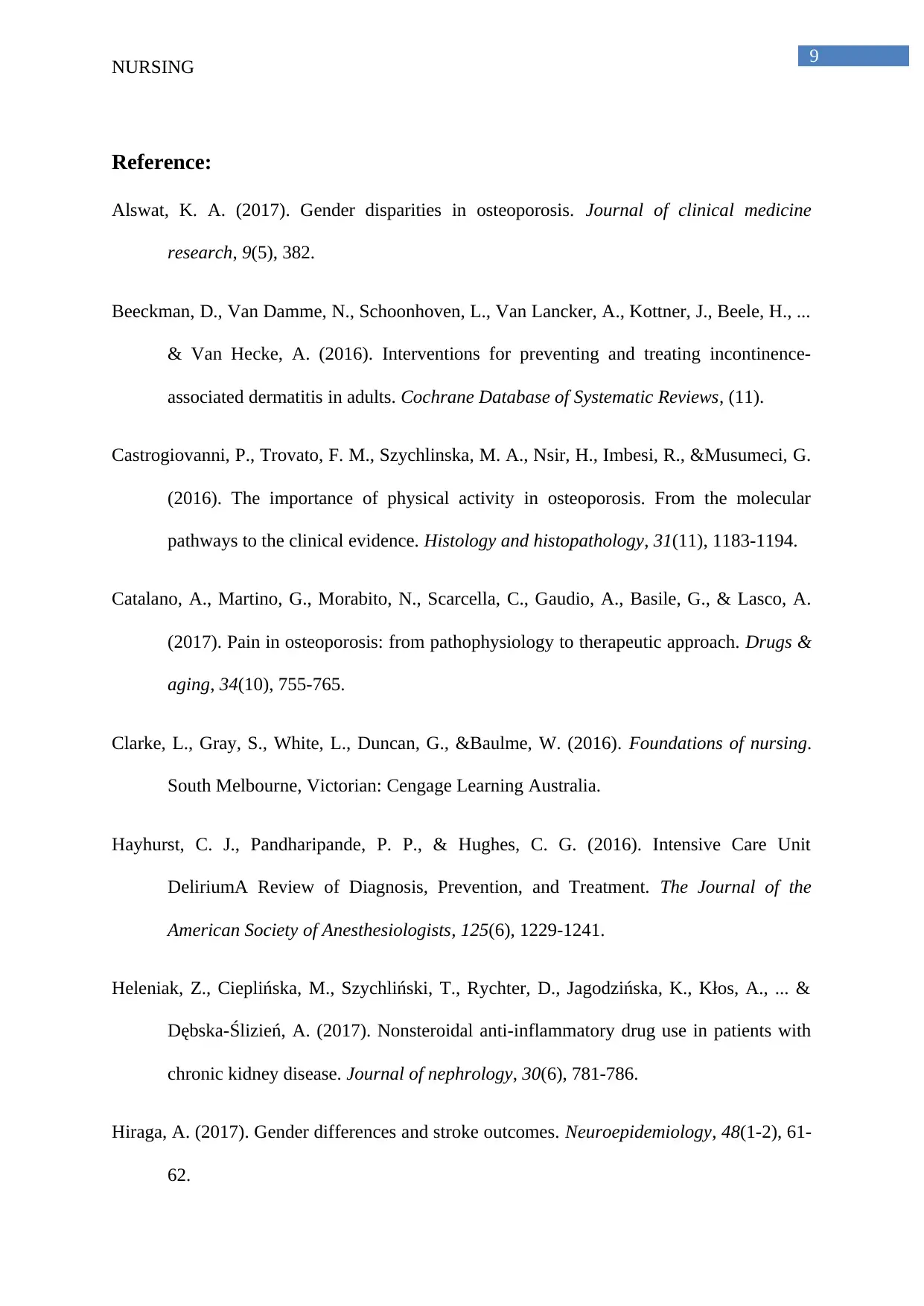
9
NURSING
Reference:
Alswat, K. A. (2017). Gender disparities in osteoporosis. Journal of clinical medicine
research, 9(5), 382.
Beeckman, D., Van Damme, N., Schoonhoven, L., Van Lancker, A., Kottner, J., Beele, H., ...
& Van Hecke, A. (2016). Interventions for preventing and treating incontinence‐
associated dermatitis in adults. Cochrane Database of Systematic Reviews, (11).
Castrogiovanni, P., Trovato, F. M., Szychlinska, M. A., Nsir, H., Imbesi, R., &Musumeci, G.
(2016). The importance of physical activity in osteoporosis. From the molecular
pathways to the clinical evidence. Histology and histopathology, 31(11), 1183-1194.
Catalano, A., Martino, G., Morabito, N., Scarcella, C., Gaudio, A., Basile, G., & Lasco, A.
(2017). Pain in osteoporosis: from pathophysiology to therapeutic approach. Drugs &
aging, 34(10), 755-765.
Clarke, L., Gray, S., White, L., Duncan, G., &Baulme, W. (2016). Foundations of nursing.
South Melbourne, Victorian: Cengage Learning Australia.
Hayhurst, C. J., Pandharipande, P. P., & Hughes, C. G. (2016). Intensive Care Unit
DeliriumA Review of Diagnosis, Prevention, and Treatment. The Journal of the
American Society of Anesthesiologists, 125(6), 1229-1241.
Heleniak, Z., Cieplińska, M., Szychliński, T., Rychter, D., Jagodzińska, K., Kłos, A., ... &
Dębska-Ślizień, A. (2017). Nonsteroidal anti-inflammatory drug use in patients with
chronic kidney disease. Journal of nephrology, 30(6), 781-786.
Hiraga, A. (2017). Gender differences and stroke outcomes. Neuroepidemiology, 48(1-2), 61-
62.
NURSING
Reference:
Alswat, K. A. (2017). Gender disparities in osteoporosis. Journal of clinical medicine
research, 9(5), 382.
Beeckman, D., Van Damme, N., Schoonhoven, L., Van Lancker, A., Kottner, J., Beele, H., ...
& Van Hecke, A. (2016). Interventions for preventing and treating incontinence‐
associated dermatitis in adults. Cochrane Database of Systematic Reviews, (11).
Castrogiovanni, P., Trovato, F. M., Szychlinska, M. A., Nsir, H., Imbesi, R., &Musumeci, G.
(2016). The importance of physical activity in osteoporosis. From the molecular
pathways to the clinical evidence. Histology and histopathology, 31(11), 1183-1194.
Catalano, A., Martino, G., Morabito, N., Scarcella, C., Gaudio, A., Basile, G., & Lasco, A.
(2017). Pain in osteoporosis: from pathophysiology to therapeutic approach. Drugs &
aging, 34(10), 755-765.
Clarke, L., Gray, S., White, L., Duncan, G., &Baulme, W. (2016). Foundations of nursing.
South Melbourne, Victorian: Cengage Learning Australia.
Hayhurst, C. J., Pandharipande, P. P., & Hughes, C. G. (2016). Intensive Care Unit
DeliriumA Review of Diagnosis, Prevention, and Treatment. The Journal of the
American Society of Anesthesiologists, 125(6), 1229-1241.
Heleniak, Z., Cieplińska, M., Szychliński, T., Rychter, D., Jagodzińska, K., Kłos, A., ... &
Dębska-Ślizień, A. (2017). Nonsteroidal anti-inflammatory drug use in patients with
chronic kidney disease. Journal of nephrology, 30(6), 781-786.
Hiraga, A. (2017). Gender differences and stroke outcomes. Neuroepidemiology, 48(1-2), 61-
62.
Secure Best Marks with AI Grader
Need help grading? Try our AI Grader for instant feedback on your assignments.
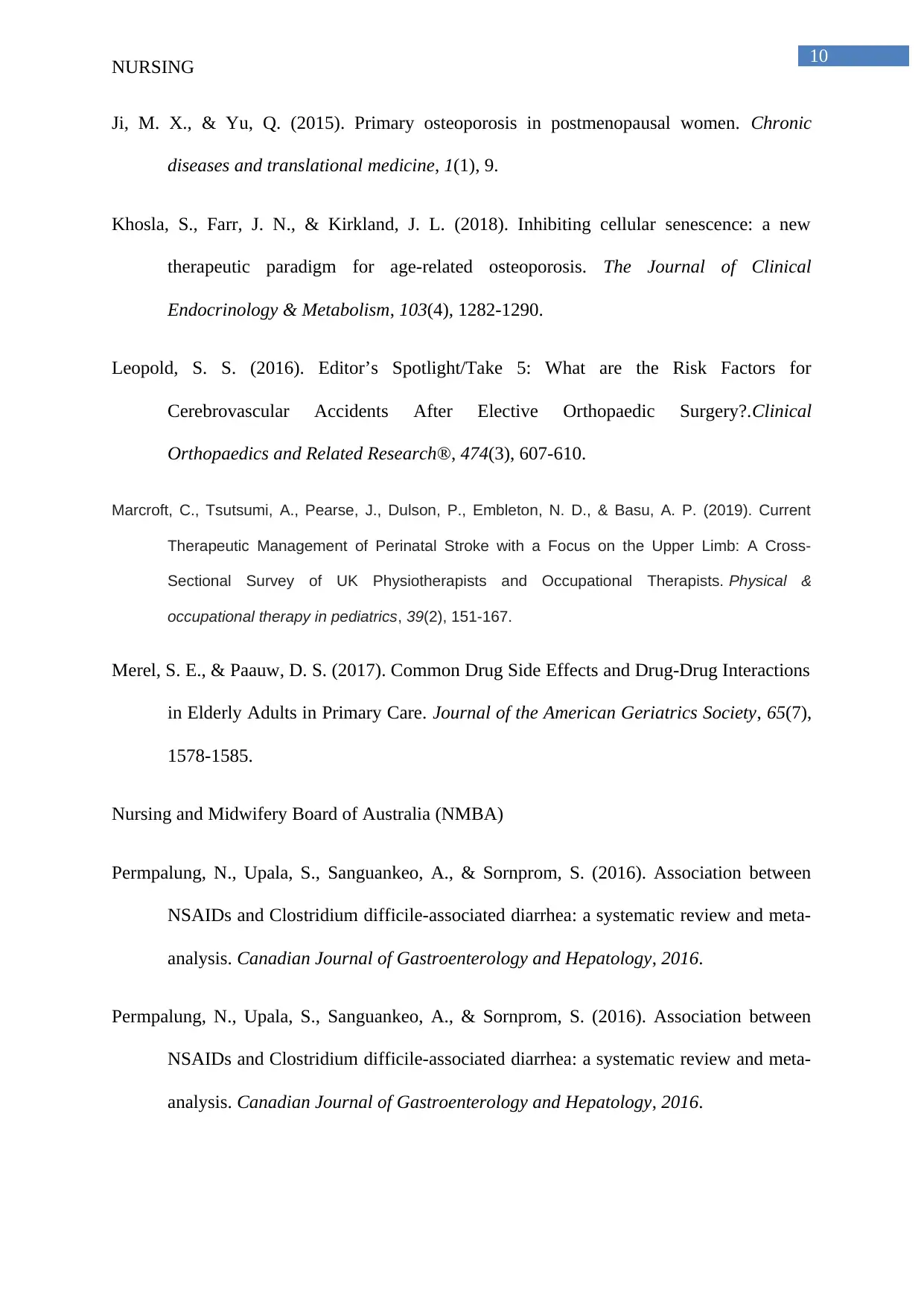
10
NURSING
Ji, M. X., & Yu, Q. (2015). Primary osteoporosis in postmenopausal women. Chronic
diseases and translational medicine, 1(1), 9.
Khosla, S., Farr, J. N., & Kirkland, J. L. (2018). Inhibiting cellular senescence: a new
therapeutic paradigm for age-related osteoporosis. The Journal of Clinical
Endocrinology & Metabolism, 103(4), 1282-1290.
Leopold, S. S. (2016). Editor’s Spotlight/Take 5: What are the Risk Factors for
Cerebrovascular Accidents After Elective Orthopaedic Surgery?.Clinical
Orthopaedics and Related Research®, 474(3), 607-610.
Marcroft, C., Tsutsumi, A., Pearse, J., Dulson, P., Embleton, N. D., & Basu, A. P. (2019). Current
Therapeutic Management of Perinatal Stroke with a Focus on the Upper Limb: A Cross-
Sectional Survey of UK Physiotherapists and Occupational Therapists. Physical &
occupational therapy in pediatrics, 39(2), 151-167.
Merel, S. E., & Paauw, D. S. (2017). Common Drug Side Effects and Drug‐Drug Interactions
in Elderly Adults in Primary Care. Journal of the American Geriatrics Society, 65(7),
1578-1585.
Nursing and Midwifery Board of Australia (NMBA)
Permpalung, N., Upala, S., Sanguankeo, A., & Sornprom, S. (2016). Association between
NSAIDs and Clostridium difficile-associated diarrhea: a systematic review and meta-
analysis. Canadian Journal of Gastroenterology and Hepatology, 2016.
Permpalung, N., Upala, S., Sanguankeo, A., & Sornprom, S. (2016). Association between
NSAIDs and Clostridium difficile-associated diarrhea: a systematic review and meta-
analysis. Canadian Journal of Gastroenterology and Hepatology, 2016.
NURSING
Ji, M. X., & Yu, Q. (2015). Primary osteoporosis in postmenopausal women. Chronic
diseases and translational medicine, 1(1), 9.
Khosla, S., Farr, J. N., & Kirkland, J. L. (2018). Inhibiting cellular senescence: a new
therapeutic paradigm for age-related osteoporosis. The Journal of Clinical
Endocrinology & Metabolism, 103(4), 1282-1290.
Leopold, S. S. (2016). Editor’s Spotlight/Take 5: What are the Risk Factors for
Cerebrovascular Accidents After Elective Orthopaedic Surgery?.Clinical
Orthopaedics and Related Research®, 474(3), 607-610.
Marcroft, C., Tsutsumi, A., Pearse, J., Dulson, P., Embleton, N. D., & Basu, A. P. (2019). Current
Therapeutic Management of Perinatal Stroke with a Focus on the Upper Limb: A Cross-
Sectional Survey of UK Physiotherapists and Occupational Therapists. Physical &
occupational therapy in pediatrics, 39(2), 151-167.
Merel, S. E., & Paauw, D. S. (2017). Common Drug Side Effects and Drug‐Drug Interactions
in Elderly Adults in Primary Care. Journal of the American Geriatrics Society, 65(7),
1578-1585.
Nursing and Midwifery Board of Australia (NMBA)
Permpalung, N., Upala, S., Sanguankeo, A., & Sornprom, S. (2016). Association between
NSAIDs and Clostridium difficile-associated diarrhea: a systematic review and meta-
analysis. Canadian Journal of Gastroenterology and Hepatology, 2016.
Permpalung, N., Upala, S., Sanguankeo, A., & Sornprom, S. (2016). Association between
NSAIDs and Clostridium difficile-associated diarrhea: a systematic review and meta-
analysis. Canadian Journal of Gastroenterology and Hepatology, 2016.
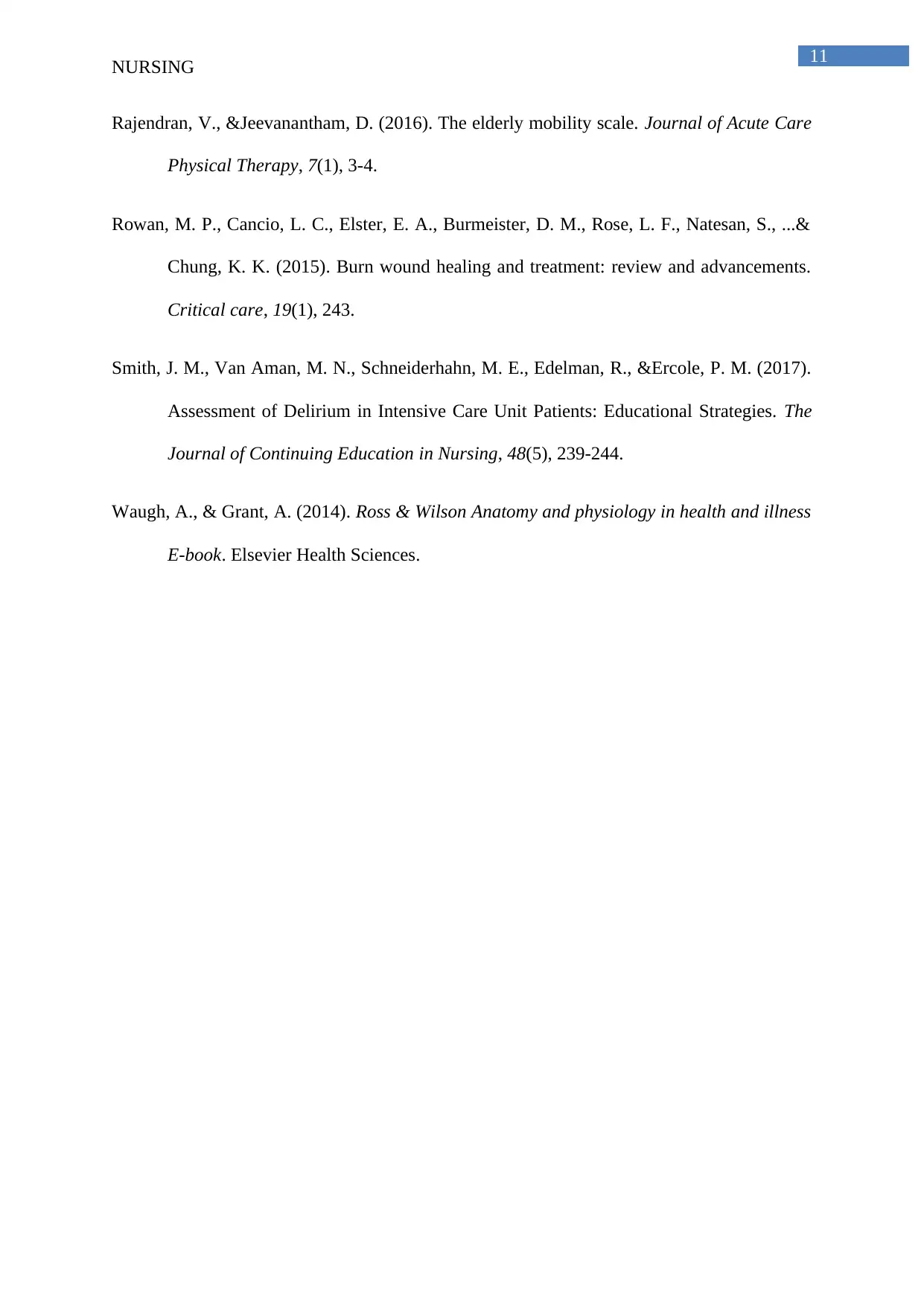
11
NURSING
Rajendran, V., &Jeevanantham, D. (2016). The elderly mobility scale. Journal of Acute Care
Physical Therapy, 7(1), 3-4.
Rowan, M. P., Cancio, L. C., Elster, E. A., Burmeister, D. M., Rose, L. F., Natesan, S., ...&
Chung, K. K. (2015). Burn wound healing and treatment: review and advancements.
Critical care, 19(1), 243.
Smith, J. M., Van Aman, M. N., Schneiderhahn, M. E., Edelman, R., &Ercole, P. M. (2017).
Assessment of Delirium in Intensive Care Unit Patients: Educational Strategies. The
Journal of Continuing Education in Nursing, 48(5), 239-244.
Waugh, A., & Grant, A. (2014). Ross & Wilson Anatomy and physiology in health and illness
E-book. Elsevier Health Sciences.
NURSING
Rajendran, V., &Jeevanantham, D. (2016). The elderly mobility scale. Journal of Acute Care
Physical Therapy, 7(1), 3-4.
Rowan, M. P., Cancio, L. C., Elster, E. A., Burmeister, D. M., Rose, L. F., Natesan, S., ...&
Chung, K. K. (2015). Burn wound healing and treatment: review and advancements.
Critical care, 19(1), 243.
Smith, J. M., Van Aman, M. N., Schneiderhahn, M. E., Edelman, R., &Ercole, P. M. (2017).
Assessment of Delirium in Intensive Care Unit Patients: Educational Strategies. The
Journal of Continuing Education in Nursing, 48(5), 239-244.
Waugh, A., & Grant, A. (2014). Ross & Wilson Anatomy and physiology in health and illness
E-book. Elsevier Health Sciences.
1 out of 12
Related Documents
Your All-in-One AI-Powered Toolkit for Academic Success.
+13062052269
info@desklib.com
Available 24*7 on WhatsApp / Email
![[object Object]](/_next/static/media/star-bottom.7253800d.svg)
Unlock your academic potential
© 2024 | Zucol Services PVT LTD | All rights reserved.





